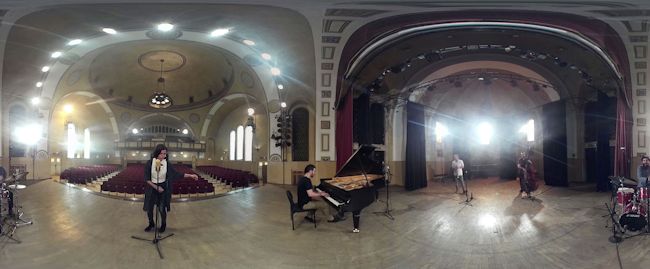You're probably familiar with 360-degree panoramic images on the web, from travel sites or when making hotel reservations. You can view a photo on the web page, and then click and drag to slide the view around so you can explore the entire scene.
But 360 is not just for images -- This year has seen a boom in support for 360-degree videos -- Full-motion videos that you can look around in, as they are playing. Now you can experience riding a boat down the Grand Canyon, or standing on stage during a musical performance, or flying up to the edge of space -- not just from the single view that was shot by a camera operator, but with the ability to look around in any direction, at any time.

Full 360 degree video - HumanEyes Vuze
And even better, getting started with viewing 360 videos is free, or at most dirt cheap.
Head on over to the YouTube 360° Videos Channel or similar sites, and just click to play them in your browser on your computer. There's no extra software to download or buy -- these play as-is in your browser. Just click and drag with your muse to look around in the view.
Plus you can display the same sites just as easily on your smartphone (or tablet). Launch the video from the smartphone browser, and then drag with your finger to change the view. Even better, since smartphones can sense when you change their position and orientation, simply tilt the smartphone to look up or down, and rotate it to look to the sides or even behind you.
So, if you just hold the smartphone in front of your eyes, and move your head and body around, you can begin to enjoy the experience of physically looking around within the space captured on the video.
 But for a more immersive experience, you need to split the scene into a pair of separate views for each eye, and use lenses to focus them properly for viewing.
But for a more immersive experience, you need to split the scene into a pair of separate views for each eye, and use lenses to focus them properly for viewing.
This does require using a VR player app on the smartphone that splits the 360 video into the two separate views, and then adjusts the viewpoint in response to your head motion so that you can naturally look around and behind, up and down.

This is the idea behind the Google Cardboard product design. These are simple headsets that use the smartphone as the display. Just slide the phone into place inside the front of the headset to view it through the lenses. Then start the video playing and look through the lenses to experience a surprising sense of realism.
The basic design is literally made from foldable cardboard, and is available from Google and others starting at $9.99 in kit form.
 Or the Vivitar Virtual Reality Glasses are especially inexpensive, at $5.99. This is a more traditional VR headset design, with an adjustable head strap, and is made from more solid plastic. The front can hold a large phone, and uses suction cups to hold the smartphone in place.
Or the Vivitar Virtual Reality Glasses are especially inexpensive, at $5.99. This is a more traditional VR headset design, with an adjustable head strap, and is made from more solid plastic. The front can hold a large phone, and uses suction cups to hold the smartphone in place.

Or for a minimalist approach, the Homido Mini VR Glasses for $14.99 are foldable lenses that simply clip on to your smartphone.
A great way to start with viewing VR videos this way is the New York Times VR site -- and its companion NYTVR apps. These provide access to a growing collection of 360 videos from the Times, plus the option to display on your smartphone in full-screen, or with dual views for a Google Cardboard or other viewer.
The good news here is that you can get started with 360 / VR videos with minimal effort and zero or minimal cost. If you'd like to make your own videos, you'll need a special camera, typically with a spherical lens and/or multiple lenses to shoot the entire surrounding scene. But prices are falling, and editing 360 videos is quickly becoming accessible with video editing software (see earlier posts on CyberLink PowerDirector 15 and Pinnacle Studio 20).
See my 360-Degree Video page for links to a selection of fun sample videos and 360 video sites, plus notes and references for more information.
See Holiday Tech 2016 for more fun holiday ideas from the mobile digital revolution.
![]() Find the Vivitar VR Glasses and Homido Mini VR Glasses on Amazon.com
Find the Vivitar VR Glasses and Homido Mini VR Glasses on Amazon.com
